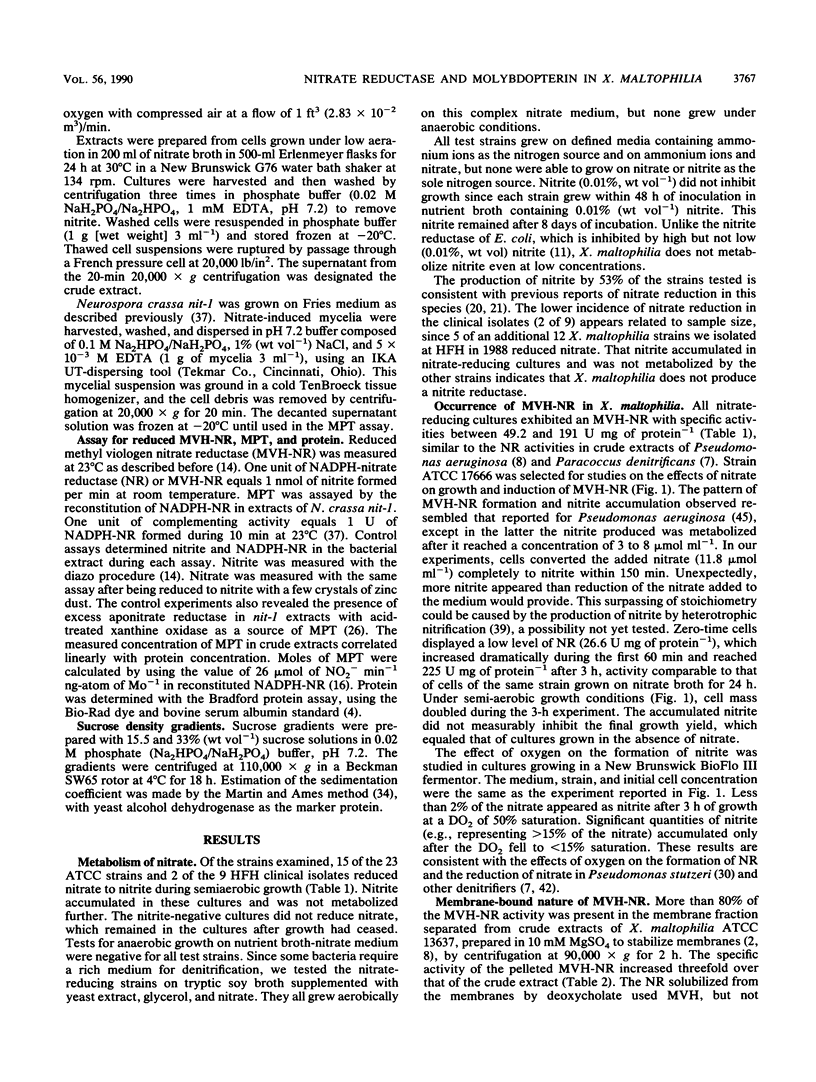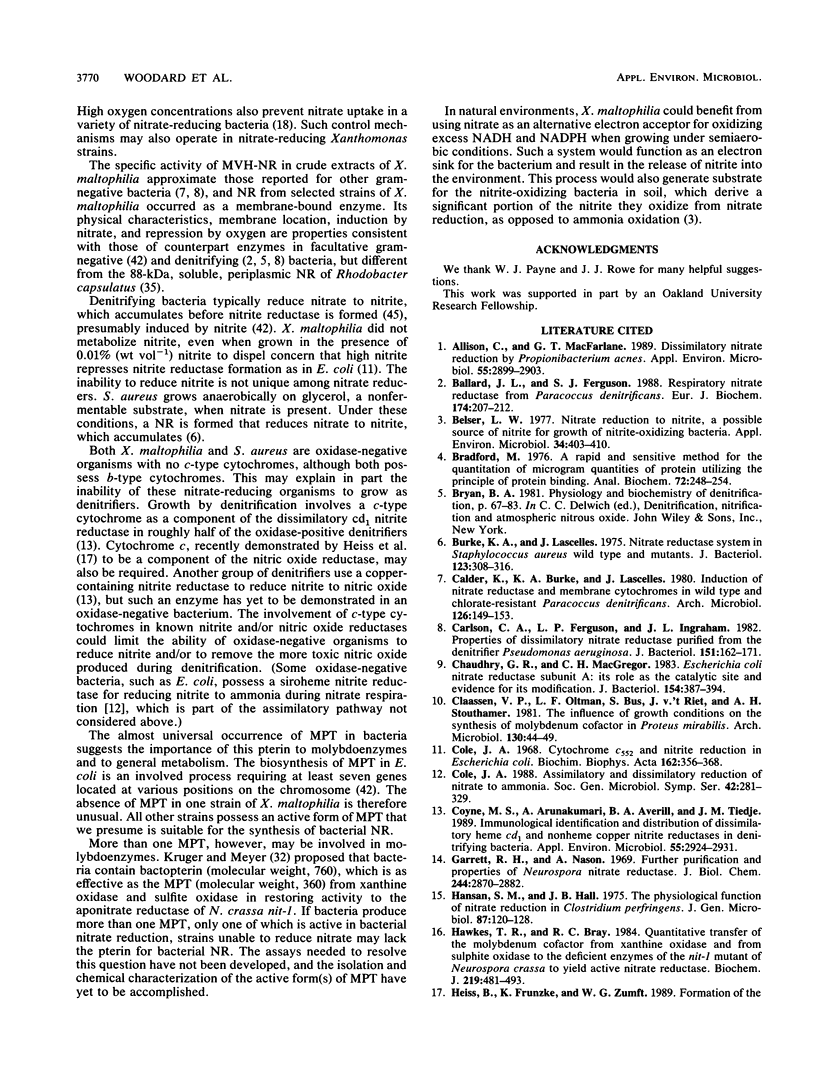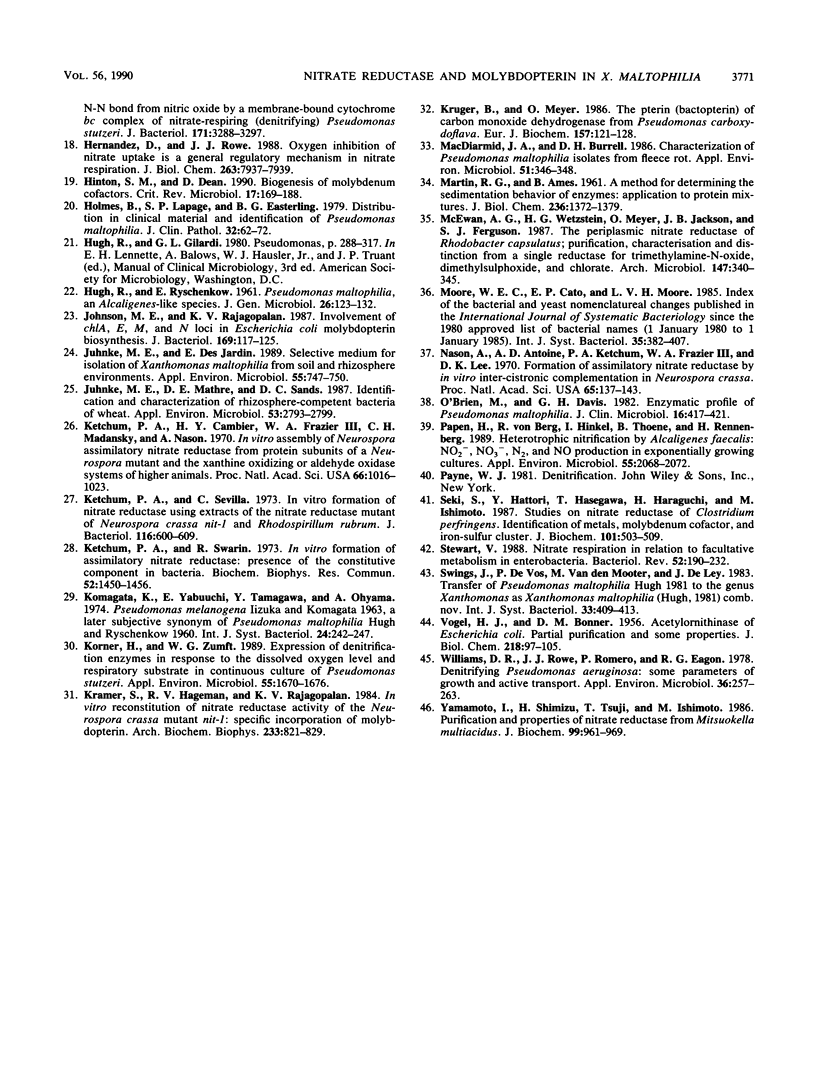Abstract
Fifteen of 23 ATCC strains and 2 of 9 clinical isolates of Xanthomonas maltophilia, all of which grew aerobically on ammonia, but not nitrate, as a sole nitrogen source, reduced nitrate to nitrite. X. maltophilia failed to grow anaerobically on complex medium with or without nitrate, so it is considered an obligate aerobe. Nitrate-reducing strains contained reduced methyl viologen nitrate reductase (MVH-NR) with specific activities ranging from 49.2 to 192 U mg of protein−1. Strain ATCC 17666 doubled its cell mass after 3 h of growth on nitrate broth under low aeration, possessed maximal MVH-NR activity, and converted the added nitrate to nitrite, which accumulated. Dissolved oxygen above 15% saturation greatly suppressed nitrite formation. All strains, except ATCC 14535, possessed between 0.25 and 5.05 pmol of molybdopterin mg of protein−1 as measured by the Neurospora crassa nit-1 assay. The molybdopterin activity in the soluble fraction sedimented as a single symmetrical peak with an s20,w of 5.1. Studies identified MVH-NR in selected strains as a membrane-bound protein. The deoxycholate-solubilized MVH-NR sedimented as a single peak in sucrose density gradients with an s20,w of 8.8. The MVH-NR of X. maltophilia has the physical characteristics of a respiratory nitrate reductase and may enable cells to use nitrate as an electron sink under semiaerobic conditions.
Full text
PDF





Selected References
These references are in PubMed. This may not be the complete list of references from this article.
- Allison C., Macfarlane G. T. Dissimilatory nitrate reduction by Propionibacterium acnes. Appl Environ Microbiol. 1989 Nov;55(11):2899–2903. doi: 10.1128/aem.55.11.2899-2903.1989. [DOI] [PMC free article] [PubMed] [Google Scholar]
- Ballard A. L., Ferguson S. J. Respiratory nitrate reductase from Paracoccus denitrificans. Evidence for two b-type haems in the gamma subunit and properties of a water-soluble active enzyme containing alpha and beta subunits. Eur J Biochem. 1988 May 16;174(1):207–212. doi: 10.1111/j.1432-1033.1988.tb14083.x. [DOI] [PubMed] [Google Scholar]
- Belser L. W. Nitrate reduction to nitrite, a possible source of nitrite for growth of nitrite-oxidizing bacteria. Appl Environ Microbiol. 1977 Oct;34(4):403–410. doi: 10.1128/aem.34.4.403-410.1977. [DOI] [PMC free article] [PubMed] [Google Scholar]
- Bradford M. M. A rapid and sensitive method for the quantitation of microgram quantities of protein utilizing the principle of protein-dye binding. Anal Biochem. 1976 May 7;72:248–254. doi: 10.1006/abio.1976.9999. [DOI] [PubMed] [Google Scholar]
- Burke K. A., Lascelles J. Nitrate reductase system in Staphylococcus aureus wild type and mutants. J Bacteriol. 1975 Jul;123(1):308–316. doi: 10.1128/jb.123.1.308-316.1975. [DOI] [PMC free article] [PubMed] [Google Scholar]
- Calder K., Burke K. A., Lascelles J. Induction of nitrate reductase and membrane cytochromes in wild type and chlorate-resistant Paracoccus denitrificans. Arch Microbiol. 1980 Jun;126(2):149–153. doi: 10.1007/BF00511220. [DOI] [PubMed] [Google Scholar]
- Carlson C. A., Ferguson L. P., Ingraham J. L. Properties of dissimilatory nitrate reductase purified from the denitrifier Pseudomonas aeruginosa. J Bacteriol. 1982 Jul;151(1):162–171. doi: 10.1128/jb.151.1.162-171.1982. [DOI] [PMC free article] [PubMed] [Google Scholar]
- Chaudhry G. R., MacGregor C. H. Escherichia coli nitrate reductase subunit A: its role as the catalytic site and evidence for its modification. J Bacteriol. 1983 Apr;154(1):387–394. doi: 10.1128/jb.154.1.387-394.1983. [DOI] [PMC free article] [PubMed] [Google Scholar]
- Claassen V. P., Oltmann L. F., Bus S., v 't Riet J., Stouthamer A. H. The influence of growth conditions on the synthesis of molybdenum cofactor in Proteins mirabilis. Arch Microbiol. 1981 Sep;130(1):44–49. doi: 10.1007/BF00527070. [DOI] [PubMed] [Google Scholar]
- Cole J. A. Cytochrome c552 and nitrite reduction in Escherichia coli. Biochim Biophys Acta. 1968 Oct 1;162(3):356–368. doi: 10.1016/0005-2728(68)90122-9. [DOI] [PubMed] [Google Scholar]
- Coyne M. S., Arunakumari A., Averill B. A., Tiedje J. M. Immunological identification and distribution of dissimilatory heme cd1 and nonheme copper nitrite reductases in denitrifying bacteria. Appl Environ Microbiol. 1989 Nov;55(11):2924–2931. doi: 10.1128/aem.55.11.2924-2931.1989. [DOI] [PMC free article] [PubMed] [Google Scholar]
- Garrett R. H., Nason A. Further purification and properties of Neurospora nitrate reductase. J Biol Chem. 1969 Jun 10;244(11):2870–2882. [PubMed] [Google Scholar]
- HUGH R., RYSCHENKOW E. Pseudomonas maltophilia, an alcaligenes-like species. J Gen Microbiol. 1961 Sep;26:123–132. doi: 10.1099/00221287-26-1-123. [DOI] [PubMed] [Google Scholar]
- Hasan S. M., Hall J. B. The physiological function of nitrate reduction in Clostridium perfringens. J Gen Microbiol. 1975 Mar;87(1):120–128. doi: 10.1099/00221287-87-1-120. [DOI] [PubMed] [Google Scholar]
- Hawkes T. R., Bray R. C. Quantitative transfer of the molybdenum cofactor from xanthine oxidase and from sulphite oxidase to the deficient enzyme of the nit-1 mutant of Neurospora crassa to yield active nitrate reductase. Biochem J. 1984 Apr 15;219(2):481–493. doi: 10.1042/bj2190481. [DOI] [PMC free article] [PubMed] [Google Scholar]
- Heiss B., Frunzke K., Zumft W. G. Formation of the N-N bond from nitric oxide by a membrane-bound cytochrome bc complex of nitrate-respiring (denitrifying) Pseudomonas stutzeri. J Bacteriol. 1989 Jun;171(6):3288–3297. doi: 10.1128/jb.171.6.3288-3297.1989. [DOI] [PMC free article] [PubMed] [Google Scholar]
- Hernandez D., Rowe J. J. Oxygen inhibition of nitrate uptake is a general regulatory mechanism in nitrate respiration. J Biol Chem. 1988 Jun 15;263(17):7937–7939. [PubMed] [Google Scholar]
- Hinton S. M., Dean D. Biogenesis of molybdenum cofactors. Crit Rev Microbiol. 1990;17(3):169–188. doi: 10.3109/10408419009105724. [DOI] [PubMed] [Google Scholar]
- Holmes B., Lapage S. P., Easterling B. G. Distribution in clinical material and identification of Pseudomonas maltophilia. J Clin Pathol. 1979 Jan;32(1):66–72. doi: 10.1136/jcp.32.1.66. [DOI] [PMC free article] [PubMed] [Google Scholar]
- Johnson M. E., Rajagopalan K. V. Involvement of chlA, E, M, and N loci in Escherichia coli molybdopterin biosynthesis. J Bacteriol. 1987 Jan;169(1):117–125. doi: 10.1128/jb.169.1.117-125.1987. [DOI] [PMC free article] [PubMed] [Google Scholar]
- Juhnke M. E., Mathre D. E., Sands D. C. Identification and characterization of rhizosphere-competent bacteria of wheat. Appl Environ Microbiol. 1987 Dec;53(12):2793–2799. doi: 10.1128/aem.53.12.2793-2799.1987. [DOI] [PMC free article] [PubMed] [Google Scholar]
- Juhnke M. E., des Jardin E. Selective medium for isolation of Xanthomonas maltophilia from soil and rhizosphere environments. Appl Environ Microbiol. 1989 Mar;55(3):747–750. doi: 10.1128/aem.55.3.747-750.1989. [DOI] [PMC free article] [PubMed] [Google Scholar]
- Ketchum P. A., Cambier H. Y., Frazier W. A., 3rd, Madansky C. H., Nason A. In vitro assembly of Neurospora assimilatory nitrate reductase from protein subunits of a Neurospora mutant and the xanthine oxidizing or aldehyde oxidase systems of higher animals. Proc Natl Acad Sci U S A. 1970 Jul;66(3):1016–1023. doi: 10.1073/pnas.66.3.1016. [DOI] [PMC free article] [PubMed] [Google Scholar]
- Ketchum P. A., Sevilla C. L. In vitro formation of nitrate reductase using extracts of the nitrate reductase mutant of Neurospora crassa, nit-1, and Rhodospirillum rubrum. J Bacteriol. 1973 Nov;116(2):600–609. doi: 10.1128/jb.116.2.600-609.1973. [DOI] [PMC free article] [PubMed] [Google Scholar]
- Ketchum P. A., Swarin R. S. In vitro formation of assimilatory nitrate reductase: presence of the constitutive component in bacteria. Biochem Biophys Res Commun. 1973 Jun 19;52(4):1450–1456. doi: 10.1016/0006-291x(73)90663-3. [DOI] [PubMed] [Google Scholar]
- Kramer S., Hageman R. V., Rajagopalan K. V. In vitro reconstitution of nitrate reductase activity of the Neurospora crassa mutant nit-1: specific incorporation of molybdopterin. Arch Biochem Biophys. 1984 Sep;233(2):821–829. doi: 10.1016/0003-9861(84)90511-3. [DOI] [PubMed] [Google Scholar]
- Krüger B., Meyer O. The pterin (bactopterin) of carbon monoxide dehydrogenase from Pseudomonas carboxydoflava. Eur J Biochem. 1986 May 15;157(1):121–128. doi: 10.1111/j.1432-1033.1986.tb09647.x. [DOI] [PubMed] [Google Scholar]
- Körner H., Zumft W. G. Expression of denitrification enzymes in response to the dissolved oxygen level and respiratory substrate in continuous culture of Pseudomonas stutzeri. Appl Environ Microbiol. 1989 Jul;55(7):1670–1676. doi: 10.1128/aem.55.7.1670-1676.1989. [DOI] [PMC free article] [PubMed] [Google Scholar]
- MARTIN R. G., AMES B. N. A method for determining the sedimentation behavior of enzymes: application to protein mixtures. J Biol Chem. 1961 May;236:1372–1379. [PubMed] [Google Scholar]
- Macdiarmid J. A., Burrell D. H. Characterization of Pseudomonas maltophilia Isolates from Fleece Rot. Appl Environ Microbiol. 1986 Feb;51(2):346–348. doi: 10.1128/aem.51.2.346-348.1986. [DOI] [PMC free article] [PubMed] [Google Scholar]
- Nason A., Antoine A. D., Ketchum P. A., Frazier W. A., 3rd, Lee D. K. Formation of assimilatory nitrate reductase by in vitro inter-cistronic complementation in Neurospora crassa. Proc Natl Acad Sci U S A. 1970 Jan;65(1):137–144. doi: 10.1073/pnas.65.1.137. [DOI] [PMC free article] [PubMed] [Google Scholar]
- O'Brien M., Davis G. H. Enzymatic profile of Pseudomonas maltophilia. J Clin Microbiol. 1982 Sep;16(3):417–421. doi: 10.1128/jcm.16.3.417-421.1982. [DOI] [PMC free article] [PubMed] [Google Scholar]
- Papen H., von Berg R., Hinkel I., Thoene B., Rennenberg H. Heterotrophic nitrification by Alcaligenes faecalis: NO2-, NO3-, N2O, and NO production in exponentially growing cultures. Appl Environ Microbiol. 1989 Aug;55(8):2068–2072. doi: 10.1128/aem.55.8.2068-2072.1989. [DOI] [PMC free article] [PubMed] [Google Scholar]
- Seki S., Hattori Y., Hasegawa T., Haraguchi H., Ishimoto M. Studies on nitrate reductase of Clostridium perfringens. IV. Identification of metals, molybdenum cofactor, and iron-sulfur cluster. J Biochem. 1987 Feb;101(2):503–509. doi: 10.1093/oxfordjournals.jbchem.a121937. [DOI] [PubMed] [Google Scholar]
- Stewart V. Nitrate respiration in relation to facultative metabolism in enterobacteria. Microbiol Rev. 1988 Jun;52(2):190–232. doi: 10.1128/mr.52.2.190-232.1988. [DOI] [PMC free article] [PubMed] [Google Scholar]
- VOGEL H. J., BONNER D. M. Acetylornithinase of Escherichia coli: partial purification and some properties. J Biol Chem. 1956 Jan;218(1):97–106. [PubMed] [Google Scholar]
- Williams D. R., Rowe J. J., Romero P., Eagon R. G. Denitrifying Pseudomonas aeruginosa: some parameters of growth and active transport. Appl Environ Microbiol. 1978 Aug;36(2):257–263. doi: 10.1128/aem.36.2.257-263.1978. [DOI] [PMC free article] [PubMed] [Google Scholar]
- Yamamoto I., Shimizu H., Tsuji T., Ishimoto M. Purification and properties of nitrate reductase from Mitsuokella multiacidus. J Biochem. 1986 Mar;99(3):961–969. doi: 10.1093/oxfordjournals.jbchem.a135559. [DOI] [PubMed] [Google Scholar]


